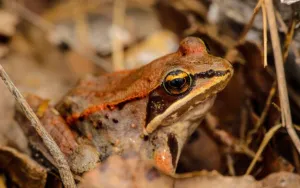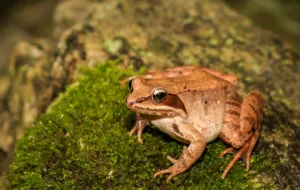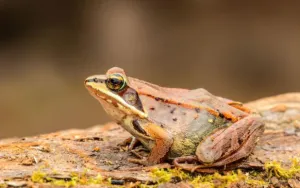
Table of Contents
Scientific Classification
- Kingdom: Animalia
- Phylum: Chordata
- Class: Amphibia
- Order: Anura
- Family: Ranidae
- Genus: Lithobates
- Species: Lithobates sylvaticus
Quick Overview
The Wood Frog (Lithobates sylvaticus) is a resilient and adaptable amphibian found in various regions of North America. Known for its remarkable freeze tolerance and distinctive markings, the wood frog is a fascinating species that has adapted to diverse environments.
Fast Facts
- Scientific Name: Lithobates sylvaticus
- Lifespan: 2 to 3 years in the wild
- Size: 2 to 3 inches in length
- Diet: Insectivorous, consuming insects and small invertebrates
- Habitat: Forested areas, wetlands, and grassy fields
- Conservation Status: Least Concern
Did you know?
Wood Frogs are known for their ability to survive being frozen during the winter months. They enter a state of suspended animation, with their hearts stopping and approximately 65% of their body water turning into ice.
Appearance
Wood Frogs exhibit a range of colors, including shades of brown, red, and tan. They are characterized by a distinct dark mask-like pattern around their eyes, which extends to their eardrums. This camouflage helps them blend seamlessly into their surroundings.
Size and Weight
Adult wood frogs typically measure between 2 to 3 inches in length. They have a moderately slender body, well-suited for their semi-aquatic lifestyle.
Temperament and Behavior
Wood Frogs are generally solitary and are most active during the breeding season. During this time, males engage in distinctive vocalizations to attract females. Outside the breeding season, they can be found foraging for small invertebrates.
Fun Fact
Wood Frogs have a unique vocalization reminiscent of quacking ducks, earning them the nickname “quacking frog.”
Habitat and Distribution
These frogs are well-distributed across North America, ranging from the boreal forests of Alaska to the northeastern United States. They prefer wooded areas near ponds, lakes, and wetlands.

Care Guide
While not commonly kept as pets due to their wild habitat needs, if kept in captivity, they require a habitat that mimics their natural environment, including access to water and appropriate hiding spots.
Diet and Nutrition
Wood Frogs are insectivores, primarily consuming a variety of small invertebrates such as insects, spiders, and worms. In captivity, a diet rich in appropriate live prey is essential.
Health and Wellness
Maintaining proper humidity and providing access to water is crucial for the health of wood frogs. They are hardy creatures, but regular observation and appropriate care contribute to their well-being.
Reproduction
Breeding occurs in spring, and males use their vocalizations to attract females. After successful mating, females lay eggs in shallow water, and the tadpoles undergo metamorphosis to become juvenile frogs.
Conservation Status
Wood Frogs are currently classified as Least Concern, indicating that their populations are stable and not facing immediate threats. However, habitat loss and pollution remain potential concerns.
Fun Fact
Wood Frogs are known for their distinct behavior called “wood frog ‘rain calls.'” During rainy nights, males gather at breeding sites and produce a chorus of calls that resembles the sound of rainfall, contributing to their unique behavioral repertoire.
Photo Gallery




Related Profiles
- American Bullfrog
- Eastern Newt
- Japanese Giant Salamander
Share This Profile
Fun Fact
Their distinctive dark mask-like patterns around the eyes serve as effective camouflage in their natural habitats.
- Enchi Ball Python: A Unique and Stunning Morph of Python regius - March 27, 2025
- Emerald Tree Monitor: The Enigmatic Green Guardian of the Rainforest - March 26, 2025
- The Egyptian Cobra (Naja haje): A Fascinating Serpent - March 25, 2025
